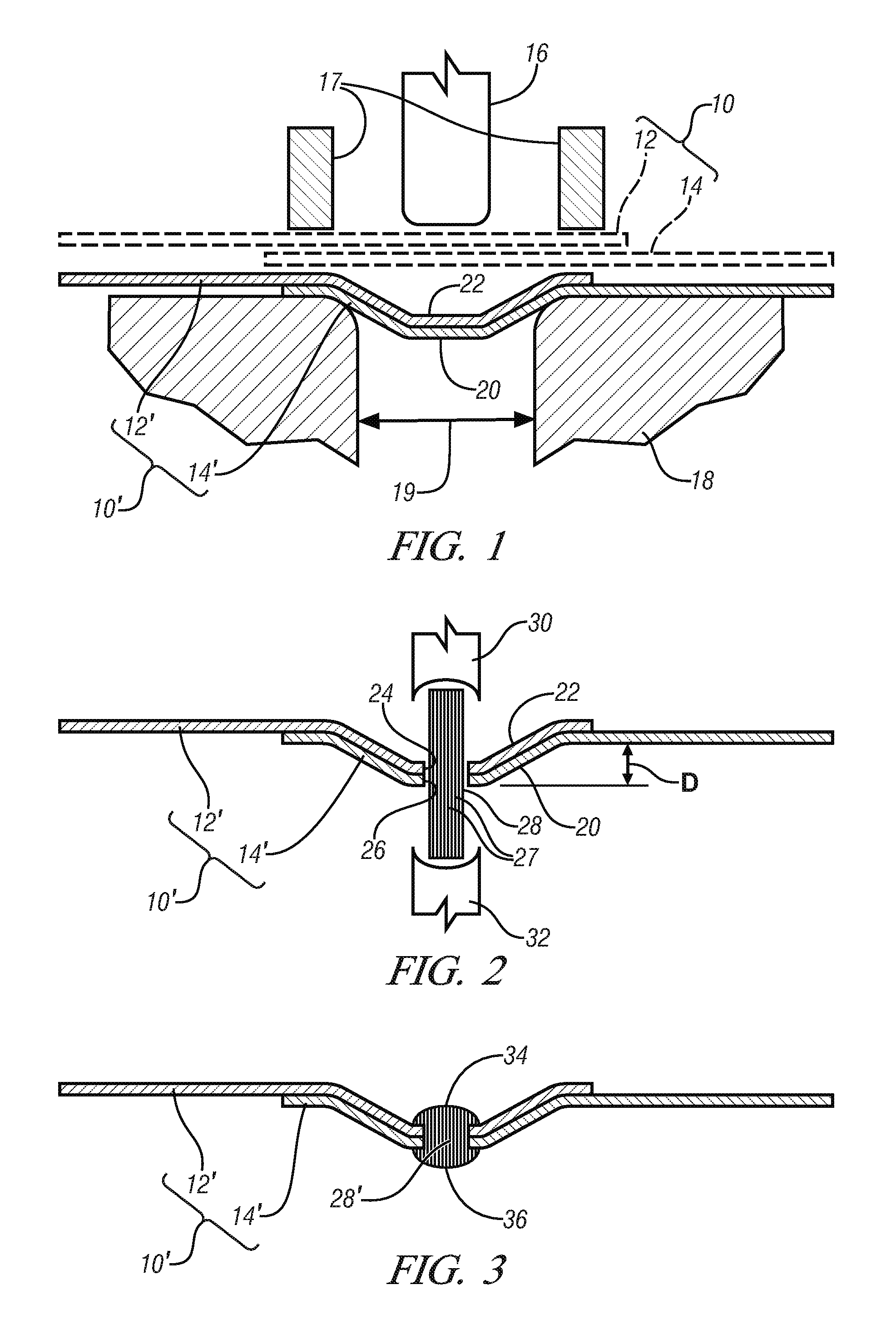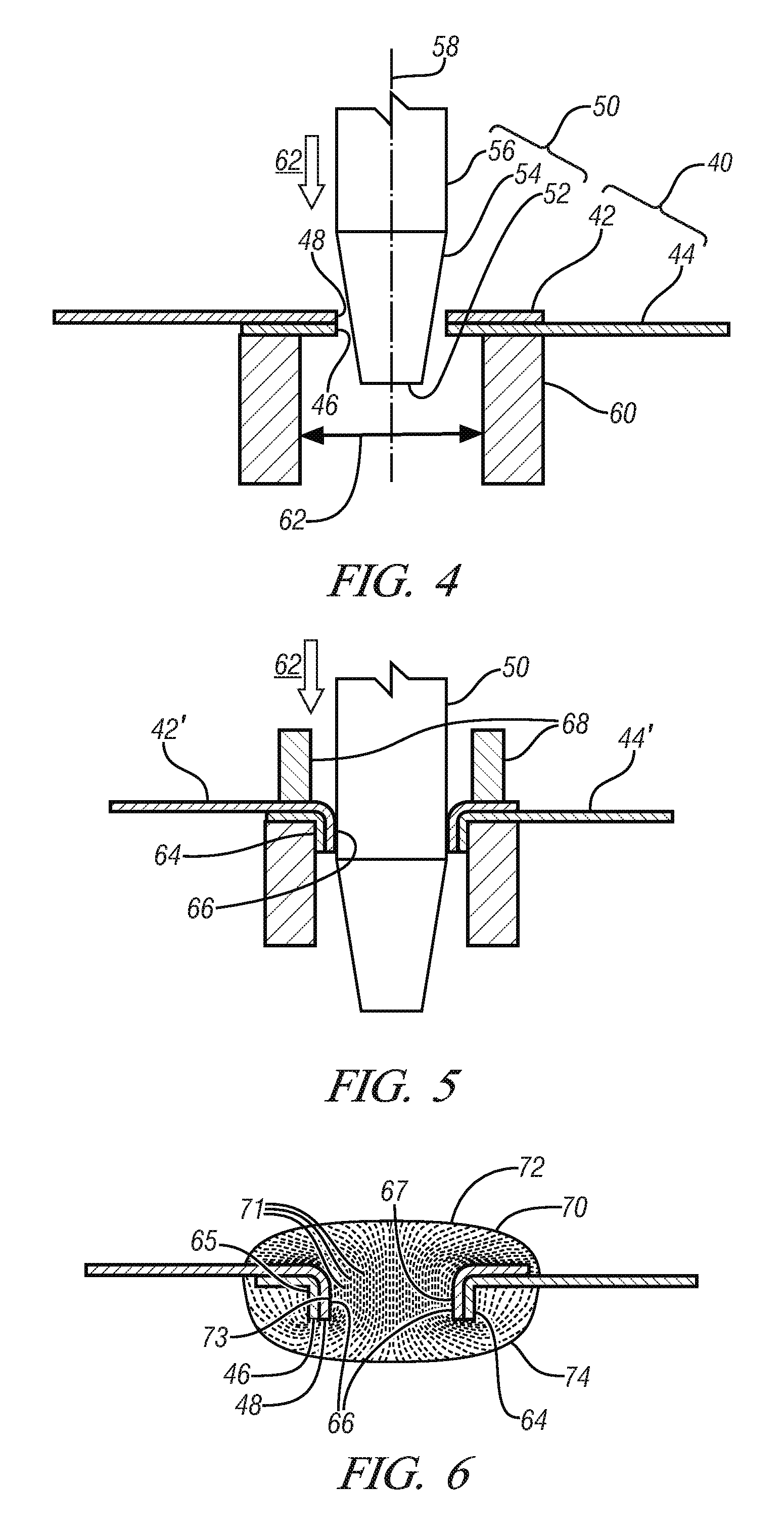Joining magnesium with reinforced polymer composite fasteners
a technology of reinforced polymer and composite fasteners, which is applied in the direction of fastening means, manufacturing tools, mechanical equipment, etc., can solve the problems of unreinforced polymers, fasteners that do not create potential galvanic corrosion between, and may not offer sufficient strength, etc., to achieve enhanced strength, significant strength to the joint, and enhancement of lap shear strength
- Summary
- Abstract
- Description
- Claims
- Application Information
AI Technical Summary
Benefits of technology
Problems solved by technology
Method used
Image
Examples
first embodiment
[0050]FIG. 1 shows, in sectional view, the invention. A workpiece stack 10, consisting of partially-overlapping sheet workpieces, 12 and 14, shown in ghost, supported by die 18 have been indented by flat-bottomed punch 16. Flat-bottomed punch 16 is centered over the throat, or die opening, 19 of die 18. As punch 16 is advanced, first into contact with the workpieces and then into die throat opening 19 the workpieces are subjected to deformation out of the plane of the sheet. Typically buckling of the sheets will be inhibited through the use of binder 17 positioned in opposition to die 18. This out-of-plane deformation of sheets 12 and 14 may form nesting, flat-bottomed, sloping-wall features 20 and 22 in deformed workpiece stack 10′ consisting of sheets 12′ and 14′. Punch 16 and die throat 19 are of complementary cross-section. It will be appreciated that if punch 16 and die throat 19 are circular in cross-section that flat-bottomed, sloping wall features 20 and 22 will have the for...
second embodiment
[0056]the invention is shown in FIG. 4 which shows, in sectional view, a workpiece stack 40 consisting of workpiece sheets 42 and 44 at least one of which is a magnesium alloy. Aligned, substantially commonly-dimensioned openings bounded by cut edges 48 and 46, have been made in the sheets by one of the previously-described approaches, and workpiece stack 40 has been positioned on die 60, with openings bounded by cut edges 48 and 46 centrally positioned in die throat 62.
[0057]Punch 50, consisting of shank 56, taper 54 and end 52, advances along symmetry axis 58, central to the die throat and substantially perpendicular to the sheet surfaces, in the direction indicated by arrow 62. End 52 of punch 50 is sized and constructed to pass through the opening as is a portion of tapered punch section 54. However the relative dimensions of punch, die opening and sheet stack thickness are such that continued advance of punch 50 will cause tapered section 54 to first engage and then downwardly ...
third embodiment
[0062]A third embodiment is illustrated in FIGS. 7-9. FIG. 7 illustrates the further deformation of flanges 64 and 66 (FIG. 5) by the shaping surface 82 of form tool 76 which further bends the flanges to bend them back on themselves to form nested, rolled-over, flanges 64′ and 66′. The end 81 of form tool 76, when directed as shown by arrow 84, is sized and constructed to enter the hole formed by inner walls 67 of inner flange 66 (FIG. 6) so that the cut surfaces 46 and 48 contact curved shaping surface 82 of tool 80. Continued motion of tool 76 will impart a moment to flanges 64 and 66 curling or bending them back on themselves to form rolled-over flanges. Backing plate 75 supports the opposing surface of the workpiece stack, and may, optionally, include features such as protrusion 78 for engagement with cavity 80 of tool 76 for guidance of tool 76.
[0063]It will be appreciated that the deformation required to form such rolled-over flanges is considerable and that significant strain...
PUM
| Property | Measurement | Unit |
|---|---|---|
| temperature | aaaaa | aaaaa |
| temperature | aaaaa | aaaaa |
| crystallization temperature | aaaaa | aaaaa |
Abstract
Description
Claims
Application Information
 Login to View More
Login to View More - R&D
- Intellectual Property
- Life Sciences
- Materials
- Tech Scout
- Unparalleled Data Quality
- Higher Quality Content
- 60% Fewer Hallucinations
Browse by: Latest US Patents, China's latest patents, Technical Efficacy Thesaurus, Application Domain, Technology Topic, Popular Technical Reports.
© 2025 PatSnap. All rights reserved.Legal|Privacy policy|Modern Slavery Act Transparency Statement|Sitemap|About US| Contact US: help@patsnap.com



